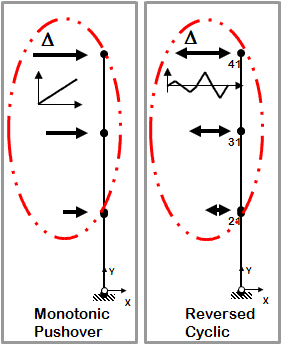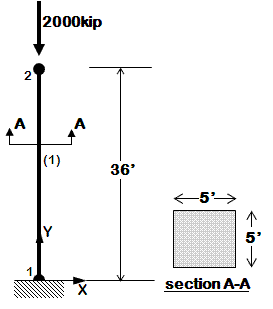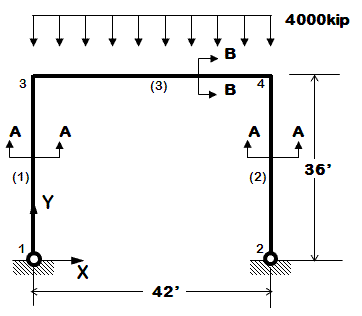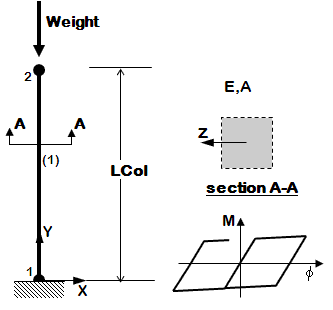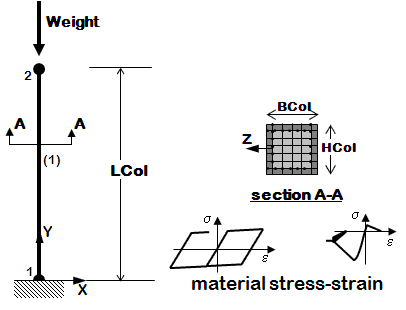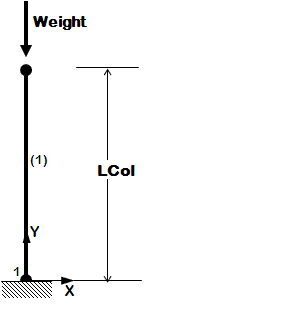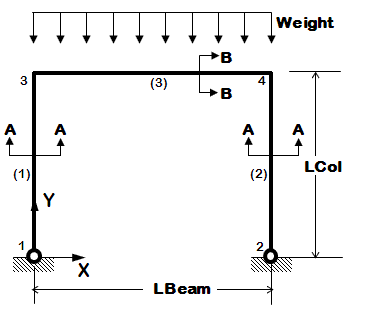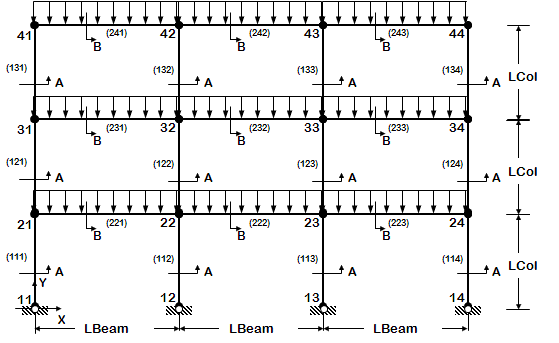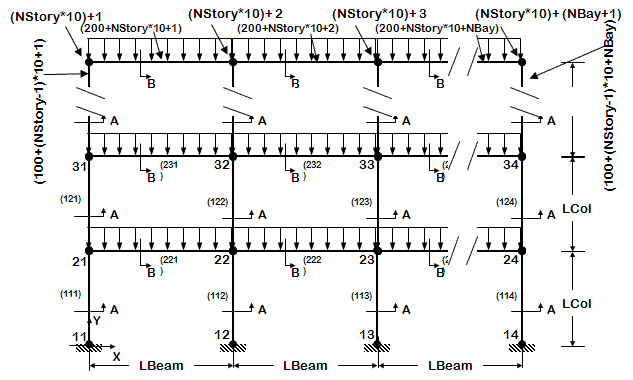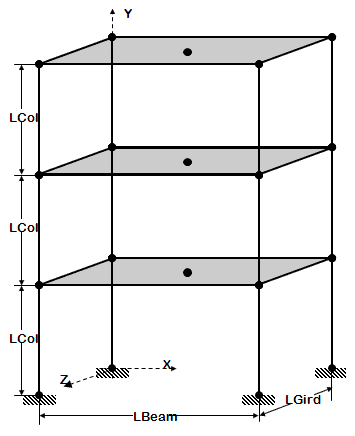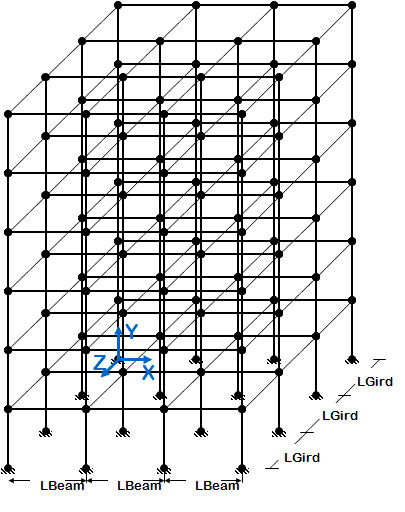Introduction
The examples in this manual are listed in order of simplicity.
NOTE: gravity analysis is always included as part of the model building
Models
The following types of models are represented in these examples:
Elastic Elements
- OpenSees Elastic Beam Column Element
- The elastic, uncoupled, axial and flexural stiffnesses are defined at the element level
- user specifies: E,I,A
Inelastic Elements
- OpenSees Force-Based Beam-Column Element
- Two types of sections
Uniaxial Section
- The inelastic, uncoupled, axial and flexural stiffnesses are defined at the section level
- The OpenSees Uniaxial Section Command is used
- User specifies:
- Axial stiffness A
- Section Moment-Curvature characteristics via the OpenSees UniaxialMaterial Command
Fiber Section
- The section is broken down into fibers where uniaxial materials are defined independently.
- The program calculates the coupled flexural and axial stiffnesses/strength by integrating strains across the section
- The OpenSees Fiber Section Command is used
- User specifies
- Stress-Strain characteristics via the OpenSees UniaxialMaterial Command for all number of materials
- Section geometry via series of Patches and Layers in the fiber section
- Two Section Geometries are presented
- *RC Rectangular Section
- *Standard AISC W section
Lateral Loads
The following types of lateral loads are represented in these examples:
Static Pushover
- Control node is located at the highest floor
- Lateral-load distribution is proportional the the mass distribution along the height of the building
- Static analysis
- Two types
Monotonic Pushover
- One-directional displacement-controlled static lateral loading
Reversed Cyclic Pushover
- One-directional displacement-controlled static lateral loading
- Displacement cycles are imposed in positive and negative direction
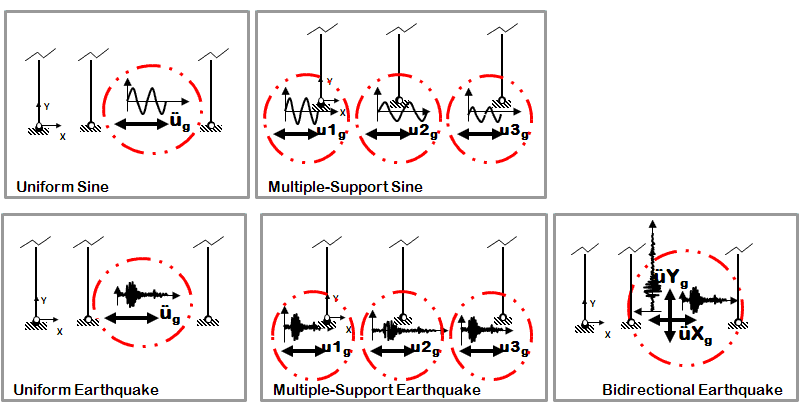
Time-Dependent Dynamic Loads
- Transient analysis
- Four types
Uniform Sine-Wave
- Sine-wave acceleration input
- Same acceleration input at all nodes restrained in specified direction
Multiple-Support Sine-Wave
- Sine-wave displacement input
- Different displacements are specified at particular nodes in specified directions
Uniform Earthquake
- Earthquake (from file) acceleration input
- Same acceleration input at all nodes restrained in specified direction
Multiple-Support Earthquake
- Earthquake (from file) displacement input
- Different displacements are specified at particular nodes in specified direction
Bidirectional Earthquake
- Different inputs are specified for two directions
- Same acceleration input at all nodes restrained in specified direction
Simulation Process
Each example script does the following:
Build the model
- model dimensions and degrees-of-freedom
- nodal coordinates
- nodal constraints -- boundary conditions
- nodal masses
- elements and element connectivity
- recorders for output
Define & apply gravity load
- nodal or element load
- static-analysis parameters (tolerances & load increments)
- analyze
- hold gravity loads constant
- reset time to zero
Define and apply lateral load
- load pattern (nodal loads for static analysis, support ground motion for earthquake)
- lateral-analysis parameters (tolerances & displacement/time increments)
- Static Lateral-Load Analysis
- define the displacement increments and displacement path
- Dynamic Lateral-Load Analysis
- define the input motion and all associated parameters, such as scaling and input type
- define analysis duration and time increment
- define damping
- analyze
Introductory Examples
The objective of Example 1a and Example 1b is to give an overview of input-file format in OpenSees using simple scripts.
These scripts do not take advantage of the Tcl scripting capabilities shown in the later examples. However, they do provide starting a place where the input file is similar to that of more familiar Finite-Element Analysis software. Subsequent examples should be used as the basis for user input files.
|
|
| Objectives
|
- overview of basic OpenSees input structure
- coordinates, boundary conditions, element connectivity, nodal masses, nodal loads, etc.
- two-node, one element
|
|
|
| Analyses
|
- static pushover
- dynamic earthquake-input
|
|
|
|
| Objectives
|
- two element types
- distributed element loads
|
|
|
| Analyses
|
- static pushover
- dynamic earthquake-input
|
|
Simple Examples of Nonlinear-Models
|
|
| Objectives
|
- introduce variable: define & use
|
|
|
| Analyses
|
- static pushover
- dynamic earthquake-input
|
|
|
|
| Objectives
|
- first example of nonlinear model, set nonlinearity at section level
|
|
| Models
|
- nonlinearBeamColumn element
- uniaxial section
|
|
| Analyses
|
- static pushover
- dynamic earthquake-input
|
|
|
|
| Objectives
|
- set nonlinearity at material level
- material stress-strain response is assembled into fiber section
- reinforced-concrete fiber section
|
|
| Models
|
- nonlinearBeamColumn element
- uniaxial material
- fiber section (Reinforced-concrete fiber section)
|
|
| Analyses
|
- static pushover
- dynamic earthquake-input
|
|
2D Structural Modeling & Analysis Examples
These examples take advantage of the Tcl scripting language starting from simple variable substitutions in the initial examples, to the more advanced techniques of array management and logical expressions (if-then statements).
|
|
| Objectives
|
- units, defined and used (they will be used in all subsequent examples)
- separate model-building and analysis files
- introduce PDelta effects (or not)
|
|
| Models
|
- elastic elements
- inelastic uniaxial section
- fiber section (Reinforced-concrete fiber section)
- Linear, PDelta or Corotational Transformation
|
|
| Analyses
|
- static pushover
- dynamic earthquake-input
|
|
|
|
| Objectives
|
- use previously-defined procedures to simplify input
- introduce more analysis types
- introduce procedure to read database input motion files (data with text in first lines)
|
|
| Models
|
- elastic elements
- inelastic uniaxial section
- inelastic fiber section (Reinforced-concrete fiber section)
|
|
| Analyses
|
- static reversed cyclic analysis
- dynamic sine-wave input analysis (uniform excitation)
- dynamic earthquake-input analysis (uniform excitation)
- dynamic sine-wave input analysis (multiple-support excitation)
- dynamic earthquake-input analysis (multiple-support excitation)
- dynamic bidirectional earthquake-input analysis (uniform excitation)
|
|
|
|
| Objectives
|
- 2D frame of fixed geometry: 3-story, 3-bay
- nodes and elements are defined manually, one by one
|
|
| Models
|
- Reinforced-Concrete Section
- Steel W-Section
- elastic uniaxial section
- inelastic uniaxial section
- inelastic fiber section
|
|
| Analyses
|
- static reversed cyclic analysis
- dynamic sine-wave input analysis (uniform excitation)
- dynamic earthquake-input analysis (uniform excitation)
- dynamic sine-wave input analysis (multiple-support excitation)
- dynamic earthquake-input analysis (multiple-support excitation)
- dynamic bidirectional earthquake-input analysis (uniform excitation)
|
|
|
|
| Objectives
|
- 2D frame geometry of variable geometry ( # stories and # bays are variables)
- node and element definition is automated
- use previously-defined procedures to view model node numbers and elements, deformed shape, and displacement history, in 2D
|
|
| Models
|
- Reinforced-Concrete Section
- Steel W-Section
- elastic uniaxial section
- inelastic uniaxial section
- inelastic fiber section
|
|
| Analyses
|
- static reversed cyclic analysis
- dynamic sine-wave input analysis (uniform excitation)
- dynamic earthquake-input analysis (uniform excitation)
- dynamic sine-wave input analysis (multiple-support excitation)
- dynamic earthquake-input analysis (multiple-support excitation)
- dynamic bidirectional earthquake-input analysis (uniform excitation)
|
|
3D Structural Modeling & Analysis Examples
A few items are new in 3D:
- Additional coordinates need to be considered in defining nodes
- Additional degrees of freedom need to be considered in defining the following:
- nodal constraints (boundary conditions)
- nodal masses
- nodal loads
- The transformation from local element/section coordinates to global system coordinates needs to be specified
- Element loads are specified in local coordinates
- Additional arguments are required for many elements (bending about local-y axis) properties
- Element/Section torsional stiffness needs to be considered
- Rigid floor diaphragms need be included for building models
|
|
| Objectives
|
- 3D frame of fixed geometry
- nodes and elements are manually manually, one by one
- introduce rigid floor diaphragm
- use previously-defined procedures to view model node numbers and elements, deformed shape, and displacement history, in 3D
|
|
| Models
|
- Reinforced-Concrete Section
- Steel W-Section
- Elastic or Fiber Section option is a variable within one input file
- rigid diaphragm
|
|
| Analyses
|
- static reversed cyclic analysis
- dynamic sine-wave input analysis (uniform excitation)
- dynamic earthquake-input analysis (uniform excitation)
- dynamic sine-wave input analysis (multiple-support excitation)
- dynamic earthquake-input analysis (multiple-support excitation)
- dynamic bidirectional earthquake-input analysis (uniform excitation)
|
|
|
|
| Objectives
|
- 3D frame geometry of variable geometry ( # stories and # bays in X and Z are variables)
- node and element definition is automated
- introduce user-input interface, the user is given the option as to what to view in model
|
|
| Models
|
- Reinforced-Concrete Section
- Steel W-Section
- Elastic or Fiber Section option is a variable within one input file
- optional rigid diaphragm
|
|
| Analyses
|
- static reversed cyclic analysis
- dynamic sine-wave input analysis (uniform excitation)
- dynamic earthquake-input analysis (uniform excitation)
- dynamic sine-wave input analysis (multiple-support excitation)
- dynamic earthquake-input analysis (multiple-support excitation)
- dynamic bidirectional earthquake-input analysis (uniform excitation)
|
|
Section Modeling And Analysis Examples
|
|
| Objectives
|
- defined section using uniaxial behavior (define moment-curvature curve) or
- define section using uniaxial materials (define stress-strain curve) in fiber section
|
|
| Models
|
- Uniaxial Nonlinear section
- Fiber Steel W-section
- Fiber RC symmetric rectangular unconfined-concrete section
- Fiber RC symmetric rectangular unconfined & confined-concrete section
- Fiber RC generalized rectangular section
- Fiber RC generalized circular section
|
|
| Analyses
|
- 2D static unidirectional moment-curvature analysis
- 3D static unidirectional moment-curvature analysis
|
|
Return to OpenSees User
